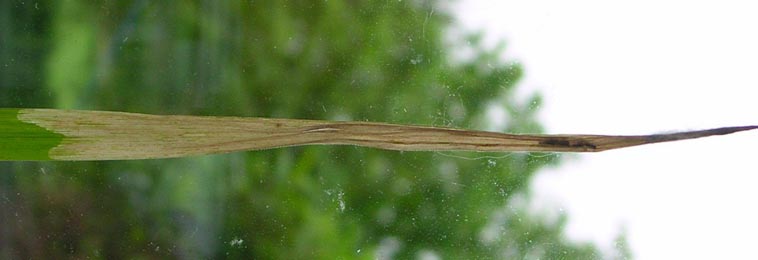|
||||||
|
BROMUS. Bromes. [Poaceae] |
|
Twenty one species of Bromus are recorded in Britain. These include the native Meadow Brome (B. commutatus), Soft-brome (B. hordeaceus), with five subspecies, Smooth Brome (B. racemosus) and Interrupted Brome (B. interruptus). The BSBI provide a downloadable plant crib for Bromus. Twenty-three British m iners are recorded on Bromus. Nearly 100 British miners or possible miners are recorded on grasses in Britain. A key to the European miners recorded on Bromus is provided in Bladmineerders van Europa. It is recommended that adults of all miners on grasses be reared to be certain of their identity. |
Key for the identification of the known mines of British |
Note: Diptera larvae may live in a corridor mine, a corridor-blotch mine, or a blotch mine, but never in a case, a rolled or folded leaf, a tentiform mine or sandwiched between two more or less circular leaf sections in later instars. Pupation never in a cocoon. All mining Diptera larvae are leg-less maggots without a head capsule (see examples). They never have thoracic or abdominal legs. They do not have chewing mouthparts, although they do have a characteristic cephalo-pharyngeal skeleton (see examples), usually visible internally through the body wall. The larvae lie on their sides within the mine and use their pick-like mouthparts to feed on plant tissue. In some corridor miners frass may lie in two rows on alternate sides of the mine. In order to vacate the mine the fully grown larva cuts an exit slit, which is usually semi-circular (see Liriomyza huidobrensis video). The pupa is formed within the hardened last larval skin or puparium and as a result sheaths enclosing head appendages, wings and legs are not visible externally (see examples). See Key to non-Diptera. |
1# > ? Leaf-miner: Details of mine and larva unknown. Because the adult fly closely resembles that of A. nigrella, possibly this applies as well to mine and larvae. Puparium dark brown |
|
Agromyza bromi Spencer, 1966 [Diptera: Agromyzidae]. |
1a > Leaf-miner: Broad elongated mine; the form is dependent of the leaf form of the host plant. Frass green. Usually a number of larvae together in a mine. Pupation in the mine. |
|
Cerodontha incisa (Meigen, 1830) [Diptera: Agromyzidae]. |
1b > Leaf-miner: A lower surface mine. Pupation normally in the ground (Spencer, 1976: 202). Broad, usually lower-surface corridor in the blade, generally first rising, then descending. Mostly one larva in a mine, but sometimes several mines on a leaf may merge. Frass in grains that gradually become both larger and more widely spaced. Pupation outside the mine. |
|
Cerodontha flavocingulata (Strobl, 1909) [Diptera: Agromyzidae]. |
1c > Leaf-miner: Normally several larvae feed together. Pupation in the mine. Puparium shining black (Spencer, 1976: 198). Broad elongated blotch. Frass greenish. Larvae generally communal. Pupation within the mine. The black puaria are individially anchored within the mine with a silken thread attached at their rear end. Distinguishable from C. incisa only by means of the larva. |
|
Cerodontha pygmaea (Meigen, 1830) [Diptera: Agromyzidae]. |
1d > Leaf-miner: Broad lower surface mine which generally starts at the leaf apex.The mine is somewhat irregular in depth. Frass in irregular black-green, frequently melted grains, mostly along the edges of the mine. Larva solitary. Pupation generally internal. |
|
Cerodontha muscina (Meigen, 1830) [Diptera: Agromyzidae]. |
1e > Leaf-miner: Long upper-surface corridor usually containing several larvae that graze shoulder to shoulder from the leaf tip downwards. Pupation outside the mine. Mines and larvae are indistinguishable from those of A. nigrella. |
|
Agromyza mobilis Meigen, 1830 [Diptera: Agromyzidae]. |
1f > Leaf-miner: Larval leaf mine starts as a narrow channel running towards apex of leaf but later develops into a broad blotch running downwards. Frass largely diffused, giving the mine a characteristic greenish appearance. Pupation external, puparium reddish brown |
|
Agromyza nigrella (Rondani, 1875) [Diptera: Agromyzidae]. |
1g > Leaf-miner: Larvae feed singly, forming an upper surface linear-blotch mine. Pupation either internal or external, with the puparium loosely glued to the leaf (Spencer, 1976: 91). Oviposition near the leaf margin, at some distance from the leaf tip. From there develops an upper-surface corridor-blotch. At first the mine ascends as a narrow corridor towards the leaf tip, then the direction turns and the mine, steadily widening, descends in the direction of the leaf base. Frass irregular, in rather coarse grains. Larva solitary. Pupation mostly outside the mine; in that case the puparium often sticks to the leaf. |
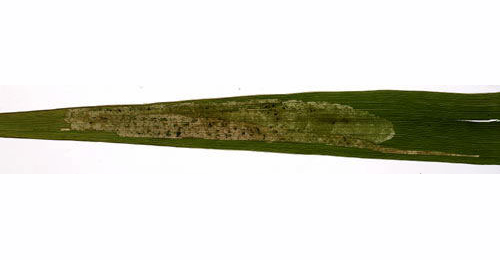 Mine of Agromyza albipennis on Phalaris arundinacea Image: © Willem Ellis (Bladmineerders van Europa) |
|
Agromyza albipennis Meigen, 1830 [Diptera: Agromyzidae]. |
1h > Leaf-miner: Mine greenish with only single larva, initially running towards apex of leaf before turning back down and developing into a broad blotch (Spencer, 1972b: 32, fig. 84; Spencer, 1976: 140, fig. 251). Deep, transparant corridor-blotch. The mine begins not far from the leaf apex, at first running upwards as a narrow corridor, then reverses and quickly widens to a blotch. A single larva per mine. Frass in isolated grains. Pupation inside or outside the mine. The mine is illustrated in the Encyclopedia of Life. Puparium reddish brown. |
|
Agromyza rondensis Strobl, 1900 [Diptera: Agromyzidae]. |
1i > Leaf-miner: Broad corridor, starting not far from the base of the blade, running upwards. Frass deliquescent, only few grains recognisable, mine greenish. Larva solitary. Pupation outside the mine. Larva: The larvae of flies are leg-less maggots without a head capsule (see examples). They never have thoracic or abdominal legs. They do not have chewing mouthparts, although they do have a characteristic cephalo-pharyngeal skeleton (see examples), usually visible internally through the body wall. The larva is described by Darvas and Papp (1985) and Darvas, Skuhravá and Andersen (2000). Mandibles each with 2 heavy teeth, front spiraculum with 11-14, rear spiraculum with 3 bulbs. The bulbs of the rear spiracula are elongated and S-shaped (d'Aguilar, Chambon and Touber, 1976a; Hering, 1957a, 1962a; Spencer, 1973b). Puparium reddish brown |
|
Agromyza intermittens (Becker, 1907) [Diptera: Agromyzidae]. |
1j > Leaf-miner: A narrow whitish linear mine, running down the leaf from the apex, with frass in two rows of separate grains. Pupation external (Spencer, 1976: 246). Narrow corridor from start to end, whitish, uppper- or lower-surface, genarally running downwards. Mine often along the leaf margin. Frass in distict grains of regular size, alternating along the sides of the corridor. Pupation outside the mine. |
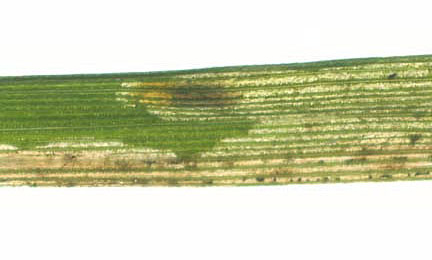 Mine of Liriomyza flaveola on Festuca gigantea Image: © Willis Ellis (Bladmineerders van Europa) |
|
Liriomyza flaveola (Fallén, 1823) [Diptera: Agromyzidae]. |
1k > Leaf-miner: Narrow whitish mine, with frass in distinct black lumps. Pupation internal (Spencer, 1976: 422). Whitish, upper-surface, descending corridor, about halfway up the blade. Frass in distinct black grains that are lying further apart than their diameter. Pupation in the mine. |
|
Chromatomyia fuscula (Zetterstedt, 1838) [Diptera: Agromyzidae]. |
1l > Leaf-miner: Long, narrow, whitish mine. Pupation internal (Spencer, 1976: 453); anterior spiracles projecting through the epidermis. Whitish, upper-surface, rather narrow corridor with comparatively large frass grains that are laying further apart than their diameter. Pupation within the mine. The anterior spiracles of the orange-brown puparium penetrate the epidermis. |
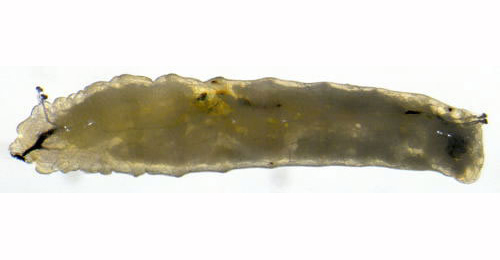 Chromatomyia nigra larva, lateral Image: © Willem Ellis (Bladmineerders van Europa) |
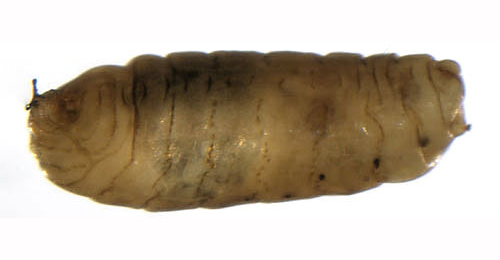 Chromatomyia nigra pupa, lateral Image: © Willem Ellis (Bladmineerders van Europa) |
|
Chromatomyia nigra (Meigen, 1830) [Diptera: Agromyzidae]. |
1m > Leaf-miner: Irregular mine, locally shallow, elsewhere much deeper, giving it a mottled appearance. In broadleaved plants the mine often begins as a blotch with stellate extensions, but sometimes as a very fine, shallow corridor. In grasses the mine often begins in the leaf sheath. The frass is very fine-grained, initially scattered, later in aggregates. The egg is deposited on the plant surface, and the empty egg shell remains visible. But the larvae are able to leave their mine and restart elsewhere, thus mines without an egg shell can be found as well. The larva also leaves the mine before pupation. Pupation takes place in a newly made, small, blotch mine without frass; this mine may be made in another plant (species). |
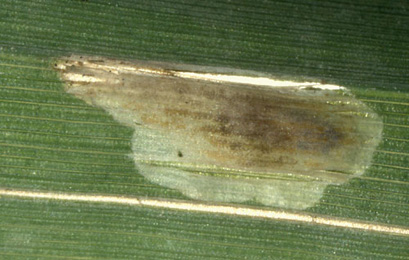 Mine of Hydrellia griseola on Glyceria fluitans Image: © Willem Ellis (Bladmineerders van Europa) |
|
Hydrellia griseola (Fallén, 1813) [Diptera: Ephydridae]. |
|
Key for the identification of the known mines of British |
||
Note: The larvae of mining Coleoptera, Hymenoptera and Lepidoptera may live in a corridor mine, a corridor-blotch mine, a blotch mine, a case, a rolled or folded leaf, a tentiform mine or sandwiched between two more or less circular leaf sections in later instars. Larva may pupate in a silk cocoon. The larva may have six legs (although they may be reduced or absent), a head capsule and chewing mouthparts with opposable mandibles (see video of a gracillarid larva feeding). Larvae of Hymenoptera and Lepidoptera usually also have abdominal legs (see examples). Frass, if present, never in two rows. Unless feeding externally from within a case the larva usually vacates the mine by chewing an exit hole. Pupa with visible head appendages, wings and legs which lie in sheaths (see examples). |
||
| 1# > Leaf-miner: Details unknown. Probably the larva mines for a few days only, and afterwards lives as a stem borer. | ||
|
||
Ochsenheimeria urella Fischer von Röslerstamm, 1842 [Lepidoptera: Ypsolophidae]. |
||
1a > Leaf/Stem miner: The larvae mine the stems of various coarse grasses (UKMoths; Plant
in Pitkin & Plant, 2005). The larva mines just a few days in the leaf, then continues as a stem borer on the lower part of the stem. They regularly move to a new stem. The central leaves of the infested plants wither and die.
|
||
| Ochsenheimeria taurella (Denis & Schiffermüller, 1775) [Lepidoptera: Ypsolophidae]. | ||
| 1b > Leaf-miner and Stem-borer: The first instar lave mines in a leaf; after that it lives as a stem borer. | ||
|
||
| Ochsenheimeria vacculella Fischer von Röslerstamm, 1842 [Lepidoptera: Ypsolophidae]. | ||
1c > Seed-feeder, leaf-miner and case-bearer: Initially it feeds on the seeds of thyme and then uses the seedhead as a case. It overwinters in this case and starts feeding again in March on grass spp. It then makes a case from the mined blade of grass. The larva initially feeds on the seeds of thyme, feeding within a floret and using this as its case. After overwintering, it changes foodplants to grass, and eventually forms an elongated case from two grass blade portions sewn together. The larva begins its life by eating out the ripe fruit of a thyme floret. The emptied and dried calyx functions as its first case, in which it hibernates. After hibernation the larva switches to grasses, initially in its original thyme case. Later a new case is made out of a mined grass leaf. This final case is about 11 mm long, two-valved, straw-coloured, has a mouth angle of 25°, and bears a striking resemblance to a grass spikelet. |
||
|
||
Coleophora lixella Zeller, 1849 [Lepidoptera: Coleophoridae] |
||
|
1d > Leaf-miner: The larva mines from the grass tip downwards and the mine occupies half or the whole of the leaf blade width. A whitish blotch is formed with characteristic narrow streaks of frass. Full depth blotch, slightly inflated, descending from the leaf tip, occupying half or the entire width of the blade. The larva may move and make a new mine elsewhere. In the latter case the mines are fairly short; otherwise an entire blade may be mined out. Frass in a some narrow greyish brown streaks. Pupation outside the mine.
|
||
Elachista albifrontella (Hübner, 1817) [Lepidoptera: Elachistidae]. |
||
|
1e > Leaf-miner: A small narrow mine on a wide variety of grasses. In the spring the larva changes leaves and mines tip downwards. The mine fills the leaf width. The frass is packed in the top of the mine. In autumn the larva makes a narrow corridor a few cm in length, in which it hibernates. In March it moves to a new leaf. Here a transparent, full depth mine is made that descends from the leaf tip, and occupies the entire width of the blade. Most frass is concentrated in the oldest, highest, part of the mine. The larva may leave its mine and restart elsewhere. Pupation outside the mine.
|
||
Elachista argentella (Clerck, 1759) [Lepidoptera: Elachistidae]. |
||
|
1f > Leaf-miner: Like related species, the larva mines blades of grass, in this case usually Cock's-foot, forming a thin whitish mine. The larva begins in autumn the making of a long, narrow, corridor with a fine central line of grey frass. The corridor is straight or lightly wavy, and descends into the leaf sheath, or even into the stem or rootstock. The larva regularly leaves the mine to begin making a new one. Pupation external.
|
||
Elachista atricomella Stainton, 1849 [Lepidoptera: Elachistidae]. |
||
|
1g > Leaf-miner: Long, flat, whitish, relatively broad corridor descending from the leaf tip. Frass irregularly scattered. The larva may make several mines during its lifetime. Pupation outside the mine.
|
||
Elachista freyerella (Hübner, 1825) [Lepidoptera: Elachistidae]. |
||
1h > Leaf-miner: Larva makes a large whitish blotch and mines the leaf downwards. The frass tends to be deposited in the upper part of the mine. Oviposition usually not far from the leaf tip. From there descends an irregular blotch mine. Hering (1957a) describes the mine as flat and quite shallow, giving it a greenish, rather than whitish appearance. Frass initially in the oldest, upper part of the mine, later in strings. The larva can leave its mine and restart elsewhere. Normally only one larva per mine, but sometimes two or even three mines in a leaf. Pupation outside the mine. |
||
|
||
Elachista maculicerusella (Bruand, 1859) [Lepidoptera: Elachistidae]. |
| Last updated 01-Jul-2019 Brian Pitkin | ||

